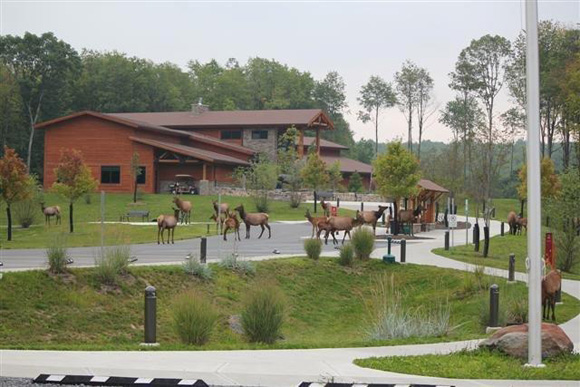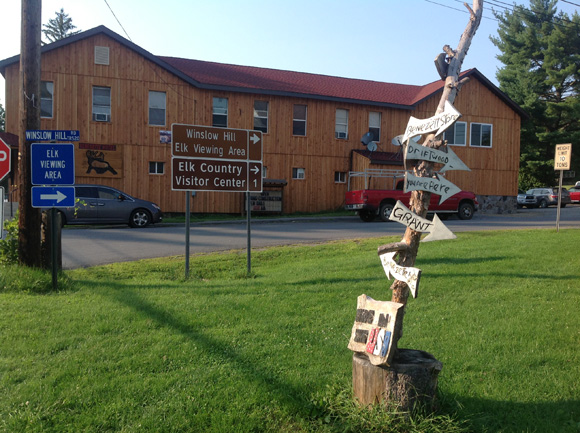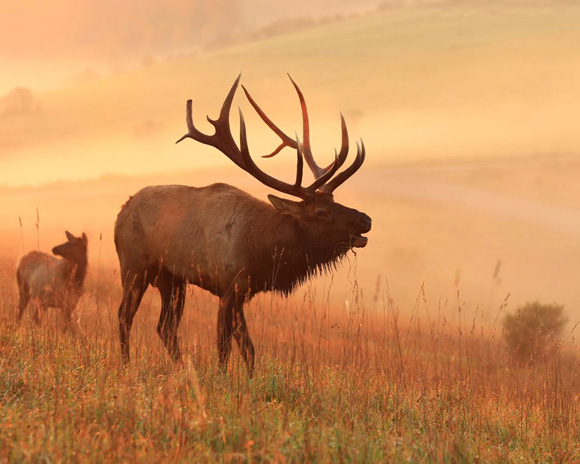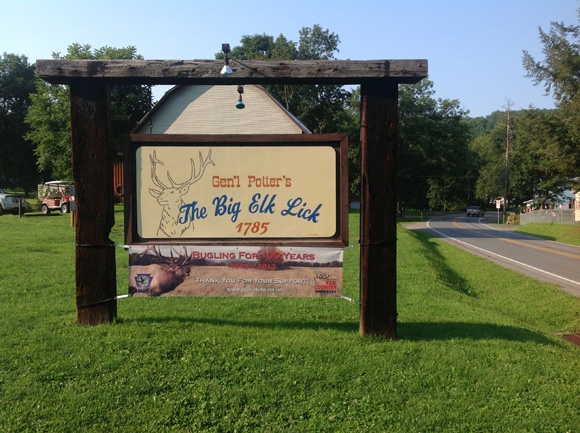Every year at this time thousands of people flock to a string of small villages in the heart of the Pennsylvania Wilds to watch and listen as the largest wild elk herd in the Northeast enters peak bugling season.
The license plates on the vehicles going into remote Bennetts Valley tell the story: New York. Pennsylvania. Virginia. Florida. Ohio. Bull elk spar in people’s yards. Dozens of cow elk and calves graze in fields near the new Elk Country Visitor Center. Elk lumber down roads, hang out in parking lots, walk through the middle of town. Big signs read: “Entering Pennsylvania’s Elk Range. Do Not Stop On Roadway. Respect Private Property.”
It is an incredible thing to witness, and people’s interest in experiencing it is driving another story unfolding here: that conserving and developing this resource was a very good idea for the region’s economy.
In the villages that surround the new Elk Country Visitor Center and in the larger towns beyond its immediate shadow, small locally-owned businesses are popping up or expanding to meet the growing demand of elk tourism, creating jobs and helping to make the Pennsylvania Wilds one of the state’s fastest-growing tourism regions.
Opportunities Everywhere
Pennsylvania’s elk weren’t always a draw. They were hunted to extinction in the late 1800s and gone from the state’s landscape completely for about 50 years when in 1913 the Pennsylvania Game Commission reintroduced them to PA; 177 came by train from Yellowstone National Park.
The herd made a comeback, but by the early 1980s, things did not look good, according to Rawley Cogan, president of the Keystone Elk Country Alliance (KECA), the nonprofit conservation group that runs the new Elk Country Visitor Center for the PA Department of Conservation and Natural Resources who owns the facility.
“When I came here in ’82 we had about 100 elk,” said Cogan, who used to work as a biologist for the Game Commission. “Not many people knew they were here and even fewer cared.”
The assumption at first was that brain worm was killing the elk, Cogan said, but then studies showed that accounted for less than 1 percent of elk deaths and that the real problem was people. Poaching, problems with crop degradation — “I kid you not I would spend the better part of my shift chasing dead elk,” Cogan said.
With hard work by the PGC, DCNR and other wildlife organizations to expand and improve elk habitat and build public awareness about the elk herd’s potential, its numbers have increased nine fold and visitation has followed suit.
“I remember Winslow Hill in the evening and there would be six cars and that would be a big deal,” Cogan said. “Things really started to ramp up in the middle to late 90s. It was all word of mouth. You started to see small traffic jams. There was no destination point. We needed a destination.”
DCNR worked with partners to fund a study by Fermata Inc on not only the potential of elk tourism in the area but how to mitigate negative impacts to the surrounding community. It was the 2002 “Plan for Elk Watching and Nature Tourism in North Central Pennsylvania” that called for a variety of measures including the construction of the Elk Country Visitor Center, a world-class conservation education facility that could orient the visitor and provide them important information about safe and respectful elk viewing. It also laid the groundwork for the Pennsylvania Wilds as a regional outdoor recreation destination.
DCNR built the center atop Winslow Hill using $6 million in tax dollars and another $6 million in private-sector donations. KECA operates the center using money raised from the private sector. In the three years since it opened, annual attendance has grown from 80,000 to 200,000 and KECA’s staff has doubled from 5 to 10 to meet the demand. The center’s gift shop has become an economic engine, too, not only supporting elk conservation but many local artisans and vendors. The gift shop sells only American-made products, and about 70 percent of the vendors are from Pennsylvania, Cogan said. Many are “Proudly Made in the Pennsylvania Wilds” products by artisans from the Pennsylvania Wilds.
Vern DeLong, from Johnsonburg about an hour north, sells chocolate-covered candies at the gift shop under cheeky labels like “elk balls” and “dragon fly droppings” – a side business he started a few years ago when he sensed his manufacturing job wasn’t going to be around a lot longer. DeLong said he had hoped to sell $1,500 worth of chocolates in a month at the gift shop and was stunned when they called during peak season to say he’d sold that much in a day – bring more product.
“It was a life changer,” DeLong said. “We’re in the middle of nowhere up here. It gave you hope. The opportunities are everywhere.”
Visitor Center Growth
The economic impact goes well beyond the center’s front doors.
At the base of Winslow Hill in Benezette, the Old Bull Café opened this month in a renovated church. A block away, Doug and Sylvia Ruffo, longtime visitors to the area, retired here last year and opened Benezette Wines in a remodeled garage space. A few doors away, Brian Kunes and Matt Castle have transformed the Benezette Hotel from a town bar into a family-friendly restaurant. Benezette Hotel has grown at about 10 percent a year and just went through a major renovation to expand their restaurant seating and spruce up the building’s exterior.
“There’s a lot more businesses popping up – gift shops, wineries, new restaurants, horse-back riding,” Kunes said. “There’s more options. It’s not just come see the elk anymore.”
KECA does not market peak bugling season because it is already so popular, but the organization is actively working to increase visitation to elk country the other 10 months of the year, which businesses say has helped extend their tourism season.
“We’ve already had our busiest dinner ever,” Kunes said at a business gathering in mid-August, still a little stunned. Usually that kind of madness doesn’t arrive until peak bugling season, between Labor Day and Halloween. “We’ve never broken 400 meals from 4 to 9 (p.m.),” he explained. “We did 427 – in AUGUST. We were like Oh. My. Gosh.”
KECA is pushing to add one major monthly event each year until all 10 months of the offseason are filled. This year it was resurrecting the Elk Expo festival, which used to be a big annual event in the area but went on hiatus for the last four years. KECA co-sponsored the Expo with the area’s visitor bureau, Great Outdoors. More than 11,000 people from 14 states and two foreign countries attended.
Elkwood Arts did “very well” at the Expo, said manager Jean Karpinski. A vocational facility providing employment and training to disabled adults, Elkwood Arts uses hardwoods from the Pennsylvania Wilds donated by area lumber mills to produce a variety of items – keychains, magnets, cutting boards, ornaments, clocks, furniture — for retail and wholesale. Many of their products were on display at the Expo.
“It was our second-highest sales show and many orders came in from brochures that were handed out,” Karpinski said. “We’re very excited about this.” Their products also do well at the elk center gift shop, she said, boosting the organization’s monthly sales.
The Elk Country Visitor Center has made a huge impact on the area, said Peggy DeCarli, owner of the Medix Hotel, about 10 miles away from the center. “Education and appreciation of our area has quadrupled,” she said, adding that the facility has also helped to keep visitors in the area longer.
“In the past people would stop for lunch, drive up to Winslow Hill and leave,” DeCarli said. “Now they are stopping for lunch, visiting the viewing center for 2-3 hours and stopping back for a drink or dinner! Our area, Benezette Township, has become a destination where you visit for the day, rather than a couple of hours. We have also seen a definite change in who is visiting – more young families – and more retired folks, which thrills us especially the young families. We view that as repeat business for years to come as the children grow up and start their own families.”
DeCarli, a third-generation local, bought the Medix Hotel in 1999, after spending several years out of the area. When she returned, she said, “I was amazed at how many tourists visited. The first time I went up on Winslow Hill it was like trying to find a parking spot at a busy mall! … and it continues to grow every year.”
In the 15 years since, DeCarli’s staff has grown from 4 to 12, and she plans to expand again next spring to make more deck seating. “To be able to sit on the deck and watch elk standing in the creek, in my parking lot, and eating apples next door is an experience few people forget,” she said.
Across the street, the Elk Country Store has also expanded to include lodging, exterior renovations and new inventory. Not far off, the owners of Wapiti Woods Guest Cabins are working on an expansion to add more guest cabins.
“The growing volume of people coming to the area to enjoy the beauty of the elk, in their natural habitat, is overwhelming,” said John Bartholme from Medix Run Lodges. “We are increasing our lodging and expanding the facilities yearly … It is still discouraging to have to turn eager new-comers down (as I just did while writing this email), knowing all other facilities are also at capacity.”
“It’s amazing the infrastructure that has gone in here,” said Doty McDowell, a Wildlife Conservation Officer for the Game Commission who has lived in the region for more than two decades and been assigned to the eastern half of Elk County, which includes Benezette, since 1998. “Winslow Hill was dirt when I got here,” McDowell said. “There was nothing. Now every cabin has a rent sign – and a nice one.”
Beyond the Valley
Mass market tourism may be easy to track with admission fees, but those methods are little help in geo-tourism destinations like the Pennsylvania Wilds. The point of coming is to experience the real place – its wonders, quirks and flaws. There are a million ways to enter and leave, making tracking difficult. Still, some data related to elk tourism does exist, helping paint a picture of the growth that is occurring.
The Clarion University Small Business Development Center, which serves elk country, said it has worked with several elk-tourism related businesses since 2005 that together have created 44 jobs, retained 12 jobs and saw a change in gross sales of more than a million dollars.
Loan officials at North Central Regional Planning & Development Commission, which also serves the region, report similar trends. Prior to 2006 tourism loans hardly made a blip in North Central’s loan portfolio. Since then the organization has packaged $2.3 million in tourism loans for businesses that have created 198 jobs.
“As a result of PA Wilds in the past year we did more tourism projects than we did manufacturing,” said North Central’s Loan Program Director Pat Brennen.
And the impact isn’t contained to just Bennetts Valley where the new visitor center is located. The foot traffic spills into neighboring towns and counties, creating opportunities there.
“It’s St Marys, it’s Ridgway, it’s DuBois,” said Dave Albert, who opened Wapiti Ridge Wine Cellars in DuBois, in Clearfield County, last year with his wife (‘wapiti’ is a Native American term for elk).
With more than 1,300 hotel rooms and many of them off I-80, lodging businesses in Clearfield County definitely see an impact from elk tourism, said Clearfield County Recreation Tourism Authority Director Holly Komonczi. “Some Clearfield County businesses have (also) joined forces with businesses in Benezette making their marketing efforts stronger,” she said.
Komonczi added that the attention given to elk tourism has strengthened other tourism assets in the region. “People coming to see elk are now looking for other activities to pursue while they are in the area,” she said.
Customers who come to hunt, paddle, fish or just enjoy the quiet at Fork Ridge Ranch, a new business in Clearfield County, “all want to see the elk,” says ranch manager John Straitiff. He said sometimes he’ll load the group into a shuttle van and drive them to the visitor center in Benezette; other times they opt to drive themselves. “It’s a great day trip,” he said.
Several business owners in surrounding communities also said the public investment in elk tourism was a key factor in them starting their business.
Elk Mountain Winery, which opened in St Marys in 2010, said it went with an elk theme because the new visitor center was about to open 20 miles away. Co-owner Kevin Wolfel said it was clear before the center opened it would be a major attraction. He hasn’t been disappointed. The winery has expanded twice so far, opening outlets in Benezette and Benton, Pa. Wolfel said in an interview this spring he’s had visitors from all 50 states and 14 countries so far. They leave straight pins on a map on his winery wall. “We are shipping wine to quite a few people that were here once just to see the elk, now they are hooked on our products,” he said. “It just goes to show you the power of tourism.”
Mark and Evelyn Keiter told a similar story about Misty Pines, a cabin rental they started in neighboring Cameron County a few years ago after Mark got laid off from a good job as a foreman in a steel mill in southeastern PA.
“After visiting relatives in the area, seeing the elk for ourselves and reading the Fermata report we decided this was the area we wanted to live in,” Evelyn Keiter explained recently by email. “We knew we wanted to be in the hospitality business and saw that there was a need for it. … We pulled up stakes, sold our home and business and moved to Cameron County to escape the rat race … This was a scary undertaking but we were ready for a big change.”
The Keiters bought 40 acres with a scenic view and transformed an abandoned house on the property into two rental suites complete with private entrances, hardwood flooring and new appliances.
“With a lot of hard work, vision and hope, we turned that abandoned house into something special,” Keiter said. “As of September 5th we will have been open for five years, I almost can't believe it. The time has gone so quickly and we have met so many nice people.
“Often local people will ask us “’Why did you move here?’” Keiter said. “The one word answer would be ELK. Maybe if someone has never lived anywhere else they don't appreciate the beauty and excitement that's right outside their back door here in the PA Wilds but we are loving it. The possibility of seeing an elk or bear in our everyday travels does not grow old. Knowing that we are sharing our home with the majestic elk puts the “wild” in PA Wilds for us. We love being able to provide a quality place for people to stay while they are experiencing a glimpse of where we get to live every day. … There are so many other things to do and see in the area but the elk are the number one draw.”
Ridgway, about an hour northwest from Benezette, has felt the economic impact of elk tourism as well, according to several businesses and organizations there.
Elk County Council on the Arts Executive Director Abbi Peters said she’s seen a bump in visitation to the ECCOTA Gallery in downtown. Elk tourists are easy to spot because they’re usually excited to talk about their experiences, she said.
“We’ve found that many of the visitors have camps in the area and this may be their first time in Ridgway because up until that point they weren’t aware of what the surrounding area had to offer,” Peters said.
With more elk tourists has come more elk-related artwork, too. “I have seen a definite increase,” Peters said. “When Paul Staniszweski started with the gallery his photography focused on floral macro shots, now he shoots primarily elk and he has developed a relationship at the Visitor’s Center that allows him to get very close and personal with the elk. We are working on a photography class this fall with Paul centered around photographing elk. Other artists have added elk, or PA Wilds-related themes to their work. And during the fall we do lean toward elk themed windows to help draw in tourists in the area for elk/leaf viewing.”
Country Squirrel Outfitters, which opened in 2010 a few blocks away from the gallery, said it gets elk traffic, too. “We get questions all the time about where to go to see elk, what time of day, what time of year, asking for directions to Benezette, etc.,” said co-owner Steve Putt. “Efforts that entities like PA Wilds, Elk Country Visitors Center, DCNR, Allegheny National Forest Visitors Bureau, etc. have put forth to help promote elk viewing, and eco-tourism in general, has certainly had a huge positive impact on Ridgway, our area and our business. Especially in the fall (elk rut season) when the river activities have died down and our recreational business would otherwise be limited.”
Further north, in Wilcox, Mike Allegretto, owner of the Tannery House, another new restaurant, said visitors to Elk Country Visitor Center make up a good number of his customers as well. “A lot of people who stop in here have either been there or are going there,” he said. “Now there’s the Sky Walk at Kinzua Bridge State Park, too, so that’s another attraction.”
More than one industrial company in Elk County has remarked that the visitor center is a useful asset to them, too – a place they can take important out-of-town clients for the day for a unique and memorable experience. “We didn’t realize what a benefit that would be,” said Brad Clinton, who works for Tom Bob Outdoors, a division of Continuous Metal Technology, a powdered metals manufacturer in Ridgway.
Dave Morris, President of the PA Wilds Tourism Marketing Corporation and head of the Great Outdoors Visitor Bureau, said elk tourism has continued to grow and impact the regional economy as an income generator. “New travel support businesses have come online, recognition of the area as a travel destination has increased and travel professionals including group tour operators, travel writers and travel planners have integrated elk country into their list of recommendations.”
“The economic impact of the Elk County Visitor Center has far exceeded our wildest dreams,” said Scott Dunkelberger, director of the Center for Business Financing for the PA Department of Community and Economic Development, a key partner in the effort to grow nature tourism in the Pennsylvania Wilds. DCED has helped fund many of the small business start-ups and expansions in the region through its low-interest loan programs.
“When the decision was made to financially support the construction of the Elk Country Visitor Center, the Commonwealth hoped it would be a world-class education facility and a magnet that would attract tourists whose spending would improve the local economy,” Dunkelberger said. “It has proven to be both.”
“This is a great example of real grass roots economic development,” he said. “The money spent in the area to purchase products and services from the local artisans, eateries, and wineries etc. is truly improving the economic base of the local economy. There are former corporate professionals who have returned to the area after successful careers with national companies as well as lifelong residents who have been able to quit their 9-5 jobs to run very successful businesses in the region surrounding the visitor center.
“I am so impressed by the business acumen and tenacity of the local entrepreneurs who are seizing the opportunities presented by the influx of visitors … These entrepreneurs are working together on advertising, promotions, and special events to insure that visitors have a positive and memorable experience. It has been such a great joy for me working with these people and watching them become so successful.”
The Next 100 Years
This year marks the 100th anniversary of the reintroduction of elk into Pennsylvania. Celebratory banners hang throughout Bennetts Valley, and the Game Commission is hosting a variety of activities, including guided mountain bike trips through surrounding state game and forest lands.
McDowell, the wildlife conservation officer, said about 950 elk live in Pennsylvania today. “As tourism has grown so has our elk population,” he said. “They are doing extremely well. Other than elk in and around Benezette, there’s very little impact of the elk in the back country.”
The public’s interest in the elk creates many opportunities, including some for the Game Commission, McDowell said. About 80 percent of the people who live in the Commonwealth are non-hunters, he explained, and the elk provide an avenue for the Game Commission to interact with them. “To me it’s a unique opportunity for the PA Game Commission to have an impact on the people about wildlife,” he said. “Nowhere else in the state can a resource officer have this kind of interaction.”
DCNR’s PA Wilds Director Meredith Hill said the economic growth around the center is “impressive and gratifying” and demonstrates well the kind of strategic investments and partnerships DCNR has championed to grow nature tourism in the Pennsylvania Wilds.
Now that key destination facilities like the visitor center are in place, Hill said, a next step is to focus on linking the region’s assets together “and packaging them so they are accessible and attractive to today’s traveler. And to work with local leaders to think long-term with an eye toward sustainability on issues like protecting community character as the region grows.”
Cogan said he’s up for the challenges.
“This is some of the most beautiful wilderness in the whole state – country – and thousands of people are coming here to experience it,” he said. “That is very gratifying to me. They come to appreciate what we have and to help conserve it – that’s pretty awesome.”
↑ Top





